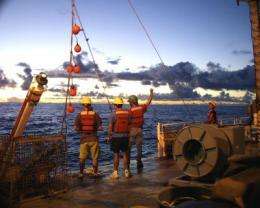Researchers reveal ocean acidification at Station ALOHA

The burning of fossil fuels has released tremendous amounts of the greenhouse gas carbon dioxide (CO2) into the atmosphere, significantly impacting global climate. Were it not for the absorption of CO2 by the oceans, the alarming growth of atmospheric CO2 concentration would be substantially greater than it is.
However, this beneficial role of the oceans as a CO2 "scrubber" does not come without undesired consequences. When dissolved, CO2 acts as an acid, and lowers seawater pH.
Since the beginning of the industrial age, CO2-driven acidification of the surface oceans has already caused a 0.1 unit lowering of pH, and models suggest that another 0.3 pH unit drop by the year 2050 is likely. Continued acidification of the sea may have a host of negative impacts on marine biota, and has the potential to alter the rates of ocean biogeochemical processes.
Despite the global environmental importance of ocean acidification, there are few studies of sufficient duration, accuracy and sampling intensity to document the rate of change of ocean pH and shed light on the factors controlling its variability. In 1988, Dave Karl and Roger Lukas of the School of Ocean, Earth Science and Technology (SOEST) at the University of Hawai'i at Mānoa founded the Hawaii Ocean Time-series (HOT) program, in part to establish a long-term record of the oceanic response to rising atmospheric CO2.
Monthly research cruises to Station ALOHA, north of Oahu, have yielded after 20 years the most detailed record to date on ocean acidification in the Pacific. Reporting in this week's issue of Proceedings of the National Academy of Sciences, lead author and former SOEST researcher John Dore (now at Montana State University) presents an analysis of the changes of pH at Station ALOHA over time and depth.
Dore, along with SOEST co-authors Karl, Lukas, Matt Church and Dan Sadler, found that over the two decades of observation, the surface ocean grew more acidic at exactly the rate expected from chemical equilibration with the atmosphere. However, that rate of change varied considerably on seasonal and inter-annual timescales, and even reversed for one period of nearly five years. The year-to-year changes appear to be driven by climate-induced changes in ocean mixing and attendant biological responses to mixing events.
The authors also found distinct layers at depth in which pH declines were actually faster than at the surface. Dore and colleagues attribute these strata of elevated acidification rates to increases in biological activity and to the intrusion at Station ALOHA of remotely formed water masses with different chemical histories.
More information: Physical and biogeochemical modulation of ocean acidification in the central North Pacific; John E. Dore, Roger Lukas, Daniel W. Sadler, Matthew J. Church and David M. Karl PNAS July 28, 2009 vol. 106 no. 30 12235-12240; Open Access article available online at www.pnas.org/content/106/30/12235
Source: University of Hawaii at Manoa















